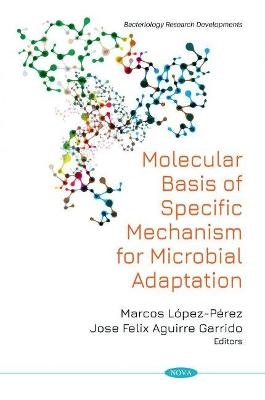
Molecular Basis of Specific Mechanism for Bacterial Adaptation
Seiten
2020
Nova Science Publishers Inc (Verlag)
978-1-5361-8751-9 (ISBN)
Nova Science Publishers Inc (Verlag)
978-1-5361-8751-9 (ISBN)
Since the appearance of Darwin's book, "The Origin of Species," adaptation is one of the processes that explains the diversity of species in ecosystems. Adaptive phenomena in the 19th century and until the mid-20th century have been analyzed in macroscopic biological systems, however since the second half of the 20th century and to date the development of disciplines such as Molecular Biology, has allowed us to delve into the mechanisms that regulate cell physiology. The molecular bases that allow explaining the adaptation processes of microorganisms to their environment have special relevance, because through their analysis it is possible to size the complexity of these mechanisms that involve receptors of a protein nature associated with transduction chains that transport the information flow to genomic DNA, and which subsequently involves the emission of a response through the expression of specific genes. From the point of view of the adaptive phenomenon analysis, the approach through the molecular bases makes it possible to understand the enormous diversity of the microbial world. Mainly for two reasons, on the one hand the presence of micro gradients in the bacterial ecological niches that are continuously fluctuating, which forces the microorganisms to a rapid adaptation phenomenon. And on the other hand, horizontal gene transfer phenomena, which allow bacteria the information exchange. These two elements carry great intensity in establishing new relationships. This phenomenon is especially relevant if it is related to a concept that Darwin cites in the Origin of Species, "The tangled riverbank", where it is emphasized that the new interactions establishment is the basic driving force for the new species generation. This mechanism is explained by the positive feedback loop generation, whereby ecosystems with high levels of biological diversity generate new interactions that lead to new species, which in turn tends to make the ecosystem network more complex. This complexity analyzed in its molecular bases allows to generate new research questions that can be applied to other knowledge areas, such as Biotechnology. The analysis of the molecular bases of the microorganisms adequacy, makes it possible to identify and characterize mechanisms that implemented in different pharmaceutical areas and agricultural industry has led to the product generation with high added value, a clear example of this economic development is the enzyme industry and even recombinant protein production. Finally, it is convenient to emphasize the need to incorporate the analysis of the molecular bases of adaptation from the perspective of omics techniques. Techniques that allow the study of processes and mechanisms to be approached from a global perspective. This book summarizes some topics of special relevance referring to adaptive processes of different microorganisms of special relevance both in basic and applied research.
Preface; Nonspecific Convergent Strategies for Bacterial Adequacy to Different Types of Environmental Stress; Molecular Mechanism Implicated in Conidia Production by Entomopathogen Fungi; Molecular Basis of Specific Strategies Used by Microorganisms to Cope with Stress: The Case of Streptomyces; Molecular Basis of Bacterial Homeostasis under Environmental Stress and Cellular Transport at Membrane Level; Laccases, a Protein System for Adaptation through the Use of Recalcitrant Resources: Molecular Basis and Computational Modeling Approaches to Uses in the Bioindustries; Host Diet and Host Derived Glycans as Primary Drivers of Microbial Gut Adaptation; Molecular Basis of Adaptation and Mechanisms Used by Halophilic Bacteria; Index.
| Erscheinungsdatum | 16.01.2021 |
|---|---|
| Sprache | englisch |
| Gewicht | 240 g |
| Themenwelt | Naturwissenschaften ► Biologie ► Mikrobiologie / Immunologie |
| ISBN-10 | 1-5361-8751-8 / 1536187518 |
| ISBN-13 | 978-1-5361-8751-9 / 9781536187519 |
| Zustand | Neuware |
| Haben Sie eine Frage zum Produkt? |
Mehr entdecken
aus dem Bereich
aus dem Bereich
Allgemeine Grundlagen und spezielle Anwendungen
Buch | Softcover (2021)
Springer Berlin (Verlag)
54,99 €


